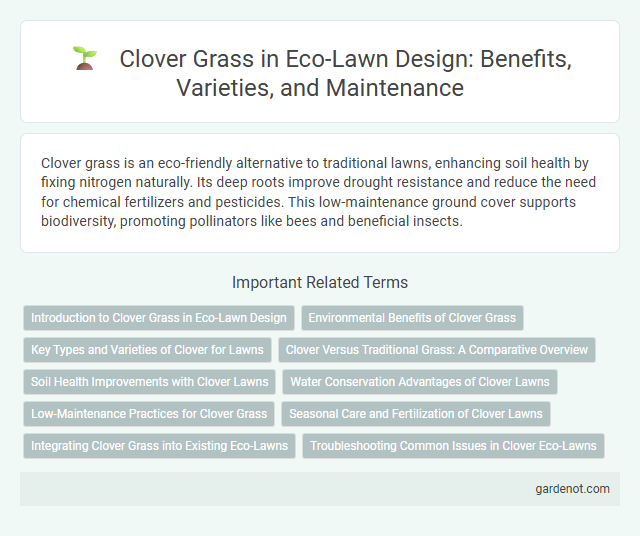Clover grass is an eco-friendly alternative to traditional lawns, enhancing soil health by fixing nitrogen naturally. Its deep roots improve drought resistance and reduce the need for chemical fertilizers and pesticides. This low-maintenance ground cover supports biodiversity, promoting pollinators like bees and beneficial insects.
Introduction to Clover Grass in Eco-Lawn Design
Clover grass is a sustainable choice in eco-lawn design due to its nitrogen-fixing properties, which naturally enrich soil fertility and reduce the need for synthetic fertilizers. Its deep root system enhances soil structure and water retention, promoting drought resilience and reducing irrigation requirements. Integrating clover grass in eco-lawns supports biodiversity by attracting pollinators such as bees and butterflies, contributing to a healthier ecosystem.
Environmental Benefits of Clover Grass
Clover grass enhances soil health by fixing atmospheric nitrogen, reducing the need for synthetic fertilizers and minimizing greenhouse gas emissions. Its deep root system improves soil structure, promotes water retention, and reduces erosion, contributing to sustainable landscaping. The plant's nectar-rich flowers support pollinator populations, fostering biodiversity and ecosystem resilience.
Key Types and Varieties of Clover for Lawns
White clover (Trifolium repens) and microclover are the most popular types for eco-lawns due to their nitrogen-fixing ability and low maintenance requirements. Dutch clover offers a denser ground cover with larger leaves, while red clover provides taller growth suited for mixed grass-clover blends. Choosing the right variety depends on local climate, soil conditions, and desired lawn appearance.
Clover Versus Traditional Grass: A Comparative Overview
Clover grass offers significant environmental benefits compared to traditional grass, including nitrogen fixation that reduces the need for synthetic fertilizers and enhances soil health. Unlike conventional lawns, clover requires less water and maintenance while promoting biodiversity by attracting pollinators like bees. Its resilience to drought and pests makes clover an eco-friendly alternative that supports sustainable landscaping practices.
Soil Health Improvements with Clover Lawns
Clover grass in eco-lawns enhances soil health by naturally fixing atmospheric nitrogen, reducing the need for synthetic fertilizers and promoting sustainable nutrient cycling. Its deep root system improves soil aeration and water retention, fostering a resilient and fertile ground environment. Incorporating clover into lawns supports biodiversity by attracting pollinators and beneficial microorganisms, further enriching soil quality and ecosystem balance.
Water Conservation Advantages of Clover Lawns
Clover grass in eco-lawns significantly reduces water consumption due to its deep root system that enhances soil moisture retention and minimizes evaporation. Unlike traditional turf grasses, clover requires less frequent irrigation, making it ideal for water-scarce regions. Its natural nitrogen-fixing ability also promotes healthier soil without over-reliance on chemical fertilizers, indirectly supporting water conservation efforts.
Low-Maintenance Practices for Clover Grass
Clover grass thrives under low-maintenance practices that include minimal mowing, infrequent fertilization, and natural pest resistance, reducing overall garden care efforts. Its nitrogen-fixing properties enhance soil fertility, decreasing the need for synthetic fertilizers and promoting sustainable growth. Clover's adaptability to various soil types and drought tolerance makes it an ideal choice for eco-friendly, low-input lawns.
Seasonal Care and Fertilization of Clover Lawns
Clover grass requires minimal seasonal care, thriving in well-drained soil with moderate watering during dry periods to maintain its lush green appearance. Fertilization should emphasize phosphorus and potassium in early spring to promote root development, while avoiding excessive nitrogen which can discourage nitrogen-fixing bacteria in clover. Regular mowing at a height of 2-3 inches supports healthy growth and reduces weed competition in clover lawns.
Integrating Clover Grass into Existing Eco-Lawns
Integrating clover grass into existing eco-lawns enhances nitrogen fixation, reducing the need for synthetic fertilizers and promoting sustainable growth. Clover's deep root system improves soil aeration and moisture retention, supporting overall lawn health and resilience. Its low-growing habit complements turf grasses, creating a dense, drought-tolerant, and pollinator-friendly lawn ecosystem.
Troubleshooting Common Issues in Clover Eco-Lawns
Clover grass in eco-lawns often faces challenges such as patchy growth due to inadequate sunlight and soil compaction, which limits nitrogen fixation efficiency and overall lawn health. Managing moisture levels is crucial, as both overwatering and drought stress can cause yellowing leaves and reduced ground cover. Regular aeration and adjusting mowing heights help maintain dense clover by promoting healthier root development and minimizing weed intrusion.
Clover grass Infographic

 gardenot.com
gardenot.com